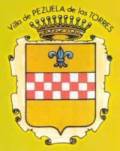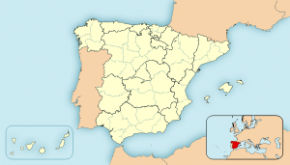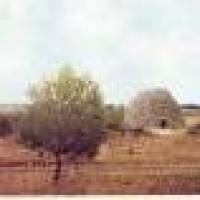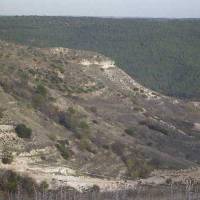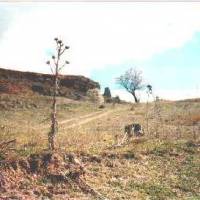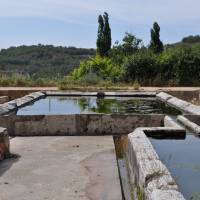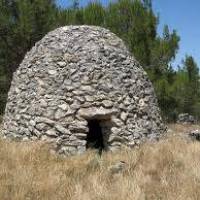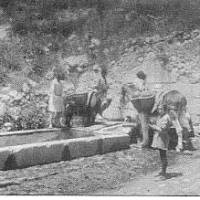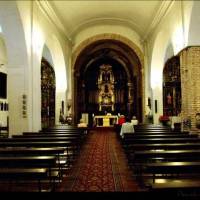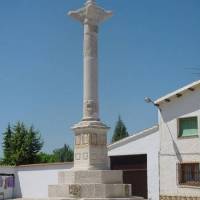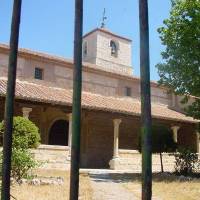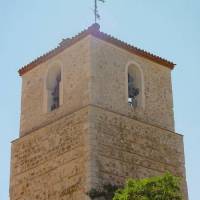PEZUELA DE LAS TORRES
The town of Pezuela of Forres is located east of the Community of Madrid in an extensive wilderness of 900 m. altitude, as part of the Alcarria, 20 km from Alcalá 30, Madrid, Guadalajara and 50.
Location of the municipality
 Located in an area of Campinas east of the Community of Madrid, known as the Alcarria of Madrid. The town is located on a large moor, at the foot of a valley town that is born will reach the river below Tajuña 2 km (approximately).
Located in an area of Campinas east of the Community of Madrid, known as the Alcarria of Madrid. The town is located on a large moor, at the foot of a valley town that is born will reach the river below Tajuña 2 km (approximately).
It belongs to the judicial Alcalá de Henares, the countryside of County Henares, Madrid province.
Neighboring Municipalities
North: Santorcaz and Pioz.
South: Olmeda de Las Fuentes and Ambite.
West: Nuevo Baztán and Corpa.
East: Loranca de Tajuña and Fuentenovilla.
Geographic Data
Area: 41,44 Km²
Altitude: 860 m
Latitude: 40°25 10’ ’’N
Longitude: 3°10’43’’ O
History
It is unknown exactly when the town was founded, it is known that the Tajuña Vega must have been inhabited before Roman times. While true, is credited with founding Pezuela the current population of the Arabs, who moved to fortify the slope in the wilderness, calling Pizol, Pesola, Peçuela, Pezuela Pozuelo and the number of wells needed to make to stock of water. The name “of the Towers” added the Count of Pezuela mid-seventeenth century.
After the reconquest of the region, Pezuela was under the jurisdiction of Guadalajara, and years later became the town of Alcala de Henares. In 1554 the Council of 180 residents, gathered 1,500,000 maravedis, with whom King Charles I paid their jurisdiction, thus the title of Villa Pezuela. In the year 1642 was awarded the title of first Earl of Don Bartholomew Spinola Pezuela.
Patrimony
Main architectural element, found in the Torres Pezuela the Parish Church of the Assumption of Our Lady presents outwardly a typical Spanish architecture of the sixteenth and eighteenth centuries, enriched in its header with a semicircular apse Romanesque perfectly restored, is one of the very few vestiges of Romanesque art in the Community of Madrid. Stresses the Bell Tower consists of two bodies and the arcaded gallery, known as “The Portalillo” built in 1536 by master masons and Hernando Alonso de la Sierra. Inside awaits a wide variety of high quality altarpieces, all baroque style with elements of rococo.
Special mention “The Pillory” Pezuela de las Torres. Restored by the City and the Community of Madrid in 2002, his tuis of 7 m. commemorated high, and warned the traveler, the power of justice and the condition of Villa, the neighbors bought the King Charles I in 1554.
Festivities and Traditions
Festivities of la Cruz de Mayo (Secondary) : is celebrated on May 3. Placement takes place in May, the rounds of the Virgin and the girls, religious ceremonies and dances.
Festivities of Santísimo Cristo del Socorro (Principal): held on September 14. Religious ceremonies are performed, dances, activities and games, various sports tournaments, activities bullfighting, fireworks, etc.
Living Nativity: recently implemented, include the representation of a Living Nativity that is developed by the town's streets and low performance of the neighbors on December 25 or Sunday close.
Pilgrimage of San Benito:
At dawn on July 11 takes place pilgrimage to the Ermita de San Benito. Procession is carried out with the image of the Holy Christ this chapel Relief located 5 km from the village, next to the River Tajuña and former wilderness. Mass is performed in honor of San Benito, and fellowship meal in the evening theater and entertainment. It remains in the image Ermita Pezuela pattern, until the evening of September 8, completed the summer, and his feast day, back in procession to the Parish Church.
Bonfire of San Antón (January 16) and San Ildefonso (January 22): that are made to cross streets by locals, with custom skip them and preparing dinner in its embers.
“Correr los Hornazos”: Easter Sunday, or “Correr la Tortilla” two months before Easter Sunday are other typical ways in which groups of friends out to the countryside to enjoy, the aforementioned typical omelet roll or country.
Hostelry
Bar los Seis Hermanos: Plaza Constitución, 4
Municipal Services
City Council Pezuela de las Torres: Plaza de la Constitución, 1 - Phone:91 886 90 80/92 77 Fax: 91 886 90 93
School - CRA. “Amigos de la Paz”: C/ Santa Ana, 10 Phone:91 886 90 93
Local Clinic: C/ Ronda, 6 - Phone:91 886 92 37
Youth Center: C/ Carnecería, 5 Phone:91 886 93 64
Socio-Cultural Center San Benito: C/ Sergio Caballero, 14 Under local
CAPI: C/ Sergio Caballero, 14 Under local
Escuela de Adultos: C/ Sergio Caballero, 14 Under local Phone:91 886 93 64
Municipal Offices (Associations and Political Parties): C/Sergio Caballero, 14 1ª Floor
Resource Catalog
Natural Resources
| Name | Classification | Description | Other Observations |
|---|---|---|---|
| LIC ES 3110006: Vegas, hills and moors of south-east of Madrid | Site of Community Importance(LIC) | Stresses the river section of Tajuña passing through the town, where in addition to the riverside forests, the fish fauna of the upper reaches of the river, favors the establishment of stable populations of Lutra lutra. | Threats: In the river Tajuña medium-high agricultural pressure, excessive stress, which break up the same river bank thickets and riparian vegetation |
| Tajuña River | Rivers, streams and riparian | Its first section in the Community of Madrid, very well preserved. | |
| Livestock Trails | Livestock Trails | There are 8 branches of roads in the municipality in all directions. Two of them connect with Olmeda de las Fuentes and Corpa. Presence of the Cañada Real Galiana south. | There seems to be resting on that goes farther north. |
| M.U.P “El Val and other” | Mounts reserved and protected: Mount of Public Utility | It is vacant land located in areas of slopes with abundant bush and shrub specimens isolated or forming clumps of Quercus coccifera and Quercus ilex | Total area: 146,80 ha. Surface protected natural area: 0 %. |
| IBA 394: “Baja Alcarria” | Other Protected Areas. Area of Important Bird SEO Birdlife. | The importance of this area is due to the remarkable community of steppe birds like to be an important area of dispersion of various raptors (Golden Eagle and Bonelli's Eagle. | |
| Orchards | Orchards peri | Watered by the water of the Fountain of the Five Pipes and laundry | |
| “La Quebrá” and White Caves | Places of scenic value | Cliffs formations that we see hanging over the valley of Tajuña the outskirts of town. This steep slopes we can find limestone caves and rock “the creek” in bold red. |
Cultural Resources
| Name | Classification | Description | Other Observations |
|---|---|---|---|
| Parish Church Asunción de Nuestra Señora | RTPP Religious Culture: Properties | In typical Spanish style architecture from the sixteenth to the eighteenth century, its architecture is enriched in the head by a semicircular apse, a vestige of the few references to the Romanesque-Castilian of the Community of Madrid. Inside a three-nave structure: that of the Epistle, dedicated to St. Anton, the gospel (dating from 1530) dedicated central San Miguel and dedicated to Our Lady of the Assumption, head of the parish. And inside we expect a wide variety of excellent quality and altarpieces of great beauty, Baroque, Rococo elements incorporated. Highlighting the main chapel, carved by master Perlacia Pezuela and Aedo Sebastian in 1766. Is to highlight the portico, known as “The Portalillo” built in 1536 by Hernando teachers and Alonso de la Sierra, and rebuilt in 1978. | The tower, built of brick, was covered with stone carved in the sixteenth century. He collapsed onto the ship to the early twentieth century, requiring major restoration work. It also preserves important books inside. The front door was made by the master José Alarcón Castañeda Mondejar in 1748. Construction materials come from the Palace of the Counts of Pezuela at that time were in ruins, having been burned in the war of succession. |
| Ermita de la Soledad o de la Vera Cruz | RTPP Religious Culture: Properties | Data from November 14, 1623, but his subsequent downfall was that it was rebuilt at the expense of neighbors and blessed Pezuela on May 7, 1742. The model structure is prevalent in the Baroque era and it is home to the Holy Sepulchre with Christ recumbent as well as images of the Virgin Head of Christ and a painting depicting St. Michael the Archangel. | Address: Cemetery Road junction with road to Calvary. |
| House of Curato | RTPP Religious Culture: Properties | XVI Century. D. Tendilla Alonso Hernandez, pastor of Pezuela waiter who had been Cardinal Cisneros at the beginning of the century was built and donated to benefit the parish. In 1706 it was destroyed by the followers of the Archiduke Charles in the War of Succession. After two years of being burned, the neighbor Friar Pedro Sanchez, decided to rebuild a new home for priests, and recalls the tombstone located above the lintel of the door. On the site of the first house was built we see, which retains the primitive gates. | Outstanding its bright windows and gates early, in perfect condition. Address: C / Mayor, 11. |
| Farm of Pontifical | RTPP Religious Culture: Properties | Built by the Church in 1789 as a store of tithes and first fruits, was a plant store. The outer socket indicates the elevation of its construction to preserve the grain of soil moisture and rodents. Its validity as a barn lasted until the confiscation of Mendizabal. | Private Property: private house. C/ Santa Ana corner with C/ Mayor. |
| Laundry - The Oil Mill | RTPP Civil Cultural: Properties | The source of the Five Pipe on the Way de la Cuesta, whose waters give the municipal utility, has been recently reconstructed. Beside him stood the old oil mill, now a private dwelling, which has a small tower with a telescope as a small astronomical observatory. | The laundry is also a good area irrigated orchards. Situated on the outskirts of town, towards the valley of Tajuña. Address: Road M-225 across camino del cementerio |
| Sources | RTPP Civil Cultural: Properties | Among the 27 sources we can find, review of the five pipes, of Valmores of Perete or tile. | It is thought that once gave the town its name. |
| Caleras | RTPP Civil Cultural: Properties | Scattered through the forest is twenty cylindrical furnaces, dug into the earth and stone, which produced lime and gypsum. | Formerly this was the most important industry in Pezuela. |
| Monument to the Regiment “Dragones de Pezuela” | RTPP Military culture: Properties | Monolith that recalls the regiment created in 1709 by Earl and Marquis of Mina Pezuela, D. Jaime de Guzman and Spinola, who fought heroically on Italian soil, had a glorious performance at Madonna del Olmo, the kingdom of Savoy, and received the name “Pezuela Dragons” or “Death.” | Jaime Guzman-Davalos, Count de las Torres Pezuela by inheritance from his mother, he spent from his youth to the military, following in the footsteps of his father. His first feat of arms took place during the War of Spanish Succession, fighting on the side Bourbon. In 1709 requests permission to King Philip V to create a regiment of dragoons at his expense. Would be known as Pezuela Regiment and later as Lusitania Regiment (whose name still survives). Guzmán-Dávalos was at its head as colonel for twenty years. |
| Cabañas de piedra | RTPP Cultural and Civil: Properties | They appear in different parts of the municipality, are curious and ancient dwellings conical and hemispherical roof that served as shelter for the shepherds. | Is kept in good condition Bullejos that of the Cerro de Zapatero, de la Cuadra, the Valbella and Don Juan. |
| La Picota | RTPP Cultural and Civil: Properties | In 1554 Pezuela neighbors 180 have brought together the council and half a million maravedis to be paid to the King Charles for the privilege of jurisdiction. To commemorate and to warn all travelers Pezuela had got the power to administer justice by itself and that it was villa, was sent up the pillory. The pillory Pezuela de las Torres is 7 meters high and is placed on some steps and crowned its high by four lions. Restored by the Community of Madrid in 2002. | As contained in “Topographical Relations” sent to Philip II, in the answers given 'in 15 days in the month of April 1578', we read that the village was the first village Pezuela the jurisdiction of Alcalá de Henares' twenty-two years to make supplication the illustrious lord Don Juan Martin Silicon, archbishop of Toledo and master of the said town of His Majesty the Emperor Don Carlos, was exempted from the jurisdiction of the town of Alcalá and gave them the privilege signed by Dona Juana, the governor of these kingdoms by his father Emperor's absence, they are all in glory, and for this reason the title of town. To commemorate and to all travelers know, was sent up the stocks'. |
| La Posada | RTPP Cultural and Civil: Properties. | XVIII Century. Where horsemen and pedestrians Posada received pension and shelter in his wanderings through this Shire Alcala Alcarria where they had won the deal and trade journals. | Restored by the City, now houses the Centre for Sociocultural, being able to cover all architectural feature Castile. |
| Wineries | RTPP Cultural and Civil : Properties | Located in the Hill of Calvary and dug into the limestone. Where once the wine was stored. | Private. Closed to within sight. |
| Covers and Grates art | RTPP Cultural and Civil : Properties | Spread the streets you can see various houses emblazoned with magnificent doors and railings and antique wrought iron handles. The Mayor and Sergio Caballero streets are the best examples: lattices of the XV and XVI. | It must have been very important Pezuela Forge and Great artists, blacksmiths, from the S. Sixteenth to the confiscation of S. XIX, made excellent ironwork seen in many windows. |
| City Council Clock | RTPP Civil Cultural: No Properties | Dates from 1708, now crown the tower of the Town Hall. In the lobby of City Hall to admire its complex operation of machinery, with masterful pieces of bronze and steel. | |
| Jaime de Guzmán y Spínola, Conde de Pezuela and Marqués de la Mina. | Historically important people | Jaime Miguel de Guzmán-Dávalos and Spinola (Sevilla, 1690 - Barcelona, 1767) was an aristocrat, military, diplomatic and Spanish enlightened governor, V Pezuela Count II of the Towers and the Marquis de la Mina, title to which is best known. As a young officer participated in the War of Succession of the ranks of King Philip V. Later, he starred in campaigns in Sicily, Sardinia (1718-20) and Italy (1743-46). He was also a distinguished diplomat, was ambassador in Paris between 1736 and 1740. Appointed Captain General of Catalonia, he served between 1749 and 1767, which killed 77 years, being buried in the church of San Miguel del Puerto. It was a great promoter of public works in Barcelona tied at the walls. Among the most notable works are the entrances to the city, the good condition of the waterways and the pavement and street lighting. But the great works of the Marquis were the buildings of Barceloneta, cleaning and dredging of the harbor, which was almost blinded by the accumulation of sand, impeding traffic originating port and flooded areas that were sites of infection. But the great military works of the Marquis were the reconstruction of the castle of Montjuic and the construction of the castle of San Fernando (Figueras), works commissioned by the General Engineer D. Juan Martin Zermeno. | As a cavalry officer, was the first Colonel of the Regiment of Lusitania. He was a supporter of the load to stab the enemy: “The cavalry never to use fire to attack, but the sword, and saber […] Dragons rifle, pistol and rifle are to charge those who retire.” |
| Santísimo Cristo del Socorro | Patron saint festivities | September 14, religious events, fireworks, dances, contests, and bullfighting. | |
| Correr la Tortilla | Popular celebrations | Two months before Easter Sunday neighbors gather in the field to eat the tortilla been developed. | |
| Correr Los Hornazos | Popular celebrations | On Easter Sunday, neighbors gather in the field to taste this local product. | |
| Living Nativity | Popular celebrations | It represents every Christmas on Saturday between 25 and 30 December. The year does not coincide with those dates any Saturday is day 25. A screenplay based on texts from the Bible, combined with traditional carols and recounts and invites the participation of visitors. The play lasts an hour and a quarter, runs around the parish church, and taking back the same people. Assembly is used in wood, old boards, branches, straw, and even a stream created for this purpose. And all those decorated with antique items and tools consistent with the time that is represented, while becoming a museum exhibition of the goods of the locals. | Source recent. Organized by the Cultural Association “Las Torres”. In 1994, with the hope that small of a family feel the Christmas spirit, began the representation of the Nativity of Jesus in private homes and garages. In 1998, with funding from the City, representation is taken to the best decorated and imagined scenario, the town streets. |
| Bonfires of San Antón and San Ildefonso | Popular celebrations | Days 16 and 22 January respectively. The neighbors make bonfires in the streets, ways skip them and still have dinner together at his side. | |
| Pilgrimage of San Benito | Popular celebrations | July 11. Pilgrimage that takes the image of the Holy Christ of Socorro to Ermita de San Benito, 5 km from the village on the banks of the river Tajuña. There it remains until September 8, which is carried back to the people, as a prior to the festivities. | |
| Los Mayos (or Celebrations of the Cruz de Mayo) | Popular celebrations | The waiters put the Mayos (a poplar height between 20 and 30 mt. In the town square and a smaller one in the church dedicated to Our Lady) on the night of April 30, through which pass the fifth and then the neighbors , to haunt the Virgin and the girls throughout the night, who welcome the spirits and sweet courtesy to the raucous youth. | They are accompanied by religious ceremonies and dances. On May 3, day of the Cruz de Mayo, rounds are married in the previous evening and the morning is taken rice pudding. |
| Business Associations | |||
| Tourism Promotion Plans |
Tourist Services
| Name | Classification | Description | Other Observations |
|---|---|---|---|
| Council website | Tourist Information Website: Municipal | Contains a brief explanation of people's sights, history, etc. | www.pezueladelastorres.es |
| Tourist brochures | Printed Publications | There are two specific brochures town: own, and one of the Community of Madrid | Himself, is also a poster of La Picota |
Other Services
| Name | Classification | Description | Other Observations |
|---|---|---|---|
| Pezuela de las Torres City Council | Cultural Center | Plaza de la Constitución, 1 - 28812 Pezuela de las Torres | Phone: 905 456 325 |
| Jiménez González | Service Station | 28812 - Pezuela de las Torres - Phone: 918 294 576 | Road M-236 |
Transport and Communications
| Name | Classification | Description | Other Observations |
|---|---|---|---|
| Line 271 | Bus | Alcalá de Henares - Pezuela de las Torres - Pioz | Monday to Friday : 07:50h to 23:00h. |
| Saturdays, Sundays and public holidays from 08:35h to 22:30h. | |||
| Sundays and public holidays at 9:30h, 13:30 and 17:30h. | |||
| Pioz - Pezuela de Las Torres - Alcalá de Henares | Monday to Friday 06:55h to 23:45h. | ||
| Saturdays, Sundays and public holidays from 09:20 to 23:30h (buses are reduced). | |||
| Phone: 918880021 | |||
| Line 274 | Bus | Madrid (Estación Sur) - Albalate de Zorita | Monday to Friday 16:00h. |
| Working Saturdays 11:30h. | |||
| Albalate de Zorita - Madrid (South Station) | Monday to Friday 06:30h. | ||
| Working Saturdays 06:30h. | |||
| Phone: 918 880 021 | |||
| Point of Information http://www.ctm-madrid.es | |||
| Intermunicipal Transport Lines | http://www.ctm-madrid.es/servlet/RedTransServlet?xh_TIPO=32&xh_ACCION=0&xh_TIPO_SEL=T&CODPANTALLA=12&xh_CLAVE=111000%23Pezuela+de+las+Torres&x=38&y=8 | ||
Routes
| Name | Classification | Description | Other Observations |
|---|---|---|---|
| Route by the Ways Pezuela Ranchers | Cycle routes | 12 km. Circular in nature. Western part of the municipality | |
| Route by el Valle del Tajuña | Cycle routes | 19 km. Important gap, the moors and meadows of the river Tajuña. |
